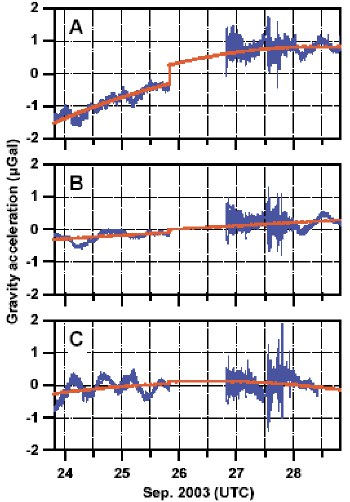Geophysicists in Japan have detected a change in the Earth's gravitational field caused by an earthquake for the first time. Yuichi Imanishi of the University of Tokyo and colleagues used an array of superconducting gravimeters to detect an increase of less than 1 micro-Galileo (10-8 metres per second per second) near the epicentre of the Tokachi-oki earthquake, which occurred in September 2003. The results agree with theoretical predictions and could help interpret measurements of the Earth's gravity made by satellites (Science 306 476).

Earthquakes occur because pressure builds up as sections of the Earth’s crust move relative to one another. These sections, known as continental plates, meet at “fault lines” and the resulting movement of mass can lead to changes in the local gravity.
Imanishi and co-workers made gravity observations at three locations, Esashi, Matsushiro and Kyoto, located approximately 373, 771 and 1040 kilometres away — as measured in a straight line — from the epicentre of the Tokachi-oki earthquake (figure 1). Tokachi-oki was a “thrust fault event” that occurred where the Pacific plate subducts beneath the North American plate. Thrust earthquakes are ideal for studying seismic gravity changes because they vertically displace adjacent blocks of mass and produce permanent changes in the gravity field around the epicentre.
Gravimeters are sensitive to both vertical displacements of the surface and density variations beneath the surface. Imanishi’s team looked at how the gravity measured by their instruments changed before and after the earthquake and found a positive offset in the data (figure 2). A change of 0.575 microgals was recorded at Esashi, with smaller changes being seen at the other two stations. However, the Earth’s gravity is about 9.8 x 108 microgals, so the largest relative change recorded was just 1 part in two billion.
To achieve this level of precision the geophysicists had to allow for tidal effects caused by the Moon and Sun, as well as for the rotation of the Earth itself. They also discarded measurements obtained immediately after the earthquake because the high-frequency seismic signals saturated the gravimeters and rendered the data unusable. Finally, the team filtered out spikes caused by aftershocks and eliminated any drift in the instruments.
The data could now be used to “ground truth” data from satellites such as the Challenging Minisatellite Payload (CHAMP) and the Gravity Recovery and Climate Experiment (GRACE).




